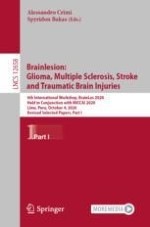2021 | OriginalPaper | Buchkapitel
Spatio-Temporal Learning from Longitudinal Data for Multiple Sclerosis Lesion Segmentation
verfasst von : Stefan Denner, Ashkan Khakzar, Moiz Sajid, Mahdi Saleh, Ziga Spiclin, Seong Tae Kim, Nassir Navab
Erschienen in: Brainlesion: Glioma, Multiple Sclerosis, Stroke and Traumatic Brain Injuries
Aktivieren Sie unsere intelligente Suche, um passende Fachinhalte oder Patente zu finden.
Wählen Sie Textabschnitte aus um mit Künstlicher Intelligenz passenden Patente zu finden. powered by
Markieren Sie Textabschnitte, um KI-gestützt weitere passende Inhalte zu finden. powered by
